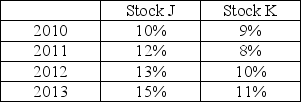Exam 8: Risk and Return
Exam 1: The Role of Managerial Finance133 Questions
Exam 2: The Financial Market Environment91 Questions
Exam 3: Financial Statements and Ratio Analysis209 Questions
Exam 4: Cash Flow and Financial Planning183 Questions
Exam 5: Time Value of Money173 Questions
Exam 6: Interest Rates and Bond Valuation224 Questions
Exam 7: Stock Valuation188 Questions
Exam 8: Risk and Return190 Questions
Exam 9: The Cost of Capital137 Questions
Exam 10: Capital Budgeting Techniques167 Questions
Exam 11: Capital Budgeting Cash Flows117 Questions
Exam 12: Risk and Refinements in Capital Budgeting106 Questions
Exam 13: Leverage and Capital Structure217 Questions
Exam 14: Payout Policy130 Questions
Exam 15: Working Capital and Current Assets Management340 Questions
Exam 16: Current Liabilities Management171 Questions
Exam 17: Hybrid and Derivative Securities185 Questions
Exam 18: Mergers, Lbos, Divestitures, and Business Failure191 Questions
Exam 19: International Managerial Finance108 Questions
Select questions type
The ________ of an asset is the change in value plus any cash distributions expressed as a percentage of the initial price or amount invested.
(Multiple Choice)
4.8/5  (38)
(38)
New investments must be considered in light of their impact on the risk and return of the portfolio of assets because the risk of any single proposed asset investment is not independent of other assets.
(True/False)
4.9/5  (37)
(37)
Nico bought 100 shares of Cisco Systems stock for $24.00 per share on January 1, 2002. He received a dividend of $2.00 per share at the end of 2002 and $3.00 per share at the end of 2003. At the end of 2004, Nico collected a dividend of $4.00 per share and sold his stock for $18.00 per share. What was Nico's realized holding period return? What was Nico's compound annual rate of return?
(Multiple Choice)
4.9/5  (31)
(31)
The steeper the slope of the security market line, the greater the degree of risk aversion.
(True/False)
4.9/5  (34)
(34)
The security market line is not stable over time and shifts in it can result in a change in required return.
(True/False)
4.9/5  (39)
(39)
In general, the lower (less positive and more negative) the correlation between asset returns,
(Multiple Choice)
4.9/5  (39)
(39)
If a person requires greater return when risk increases, that person is said to be
(Multiple Choice)
4.7/5  (29)
(29)
On average, during the past 75 years, the return on U.S. Treasury bills has exceeded the inflation rate.
(True/False)
4.8/5  (30)
(30)
On average, during the past 75 years, the inflation rate has exceeded the return on U.S. Treasury bills.
(True/False)
4.8/5  (31)
(31)
A normal probability distribution is a symmetrical distribution whose shape resembles a bell-shaped curve.
(True/False)
4.7/5  (34)
(34)
Strikes, lawsuits, regulatory actions, and increased competition are all examples of
(Multiple Choice)
4.9/5  (33)
(33)
Table 8.2
You are going to invest $20,000 in a portfolio consisting of assets X, Y, and Z, as follows:  -Nicole holds three stocks in her portfolio: A, B, and C. The portfolio beta is 1.40. Stock A comprises 15 percent of the dollar value of her holdings and has a beta of 1.0. If Nicole sells all of her investment in A and invests the proceeds in the risk-free asset, her new portfolio beta will be
-Nicole holds three stocks in her portfolio: A, B, and C. The portfolio beta is 1.40. Stock A comprises 15 percent of the dollar value of her holdings and has a beta of 1.0. If Nicole sells all of her investment in A and invests the proceeds in the risk-free asset, her new portfolio beta will be
(Multiple Choice)
4.9/5  (34)
(34)
Given the returns of two stocks J and K in the table below over the next 4 years. Find the expected return and standard deviation of holding a portfolio of 40% of stock J and 60% in stock K over the next 4 years: 
(Multiple Choice)
4.9/5  (36)
(36)
Over long periods, returns from internationally diversified portfolios tend to be superior to those yielded by purely domestic ones. Over any single short or intermediate period, however, international diversification can yield sub par returnsparticularly during periods when the dollar is appreciating in value relative to other currencies.
(True/False)
4.9/5  (38)
(38)
The relevant portion of an asset's risk attributable to market factors that affect all firms is called
(Multiple Choice)
4.8/5  (28)
(28)
Interest rate risk is the chance that changes in interest rates will adversely affect the value of an investment; most investments decline in value when the interest rates rise and increase in value when interest rates fall.
(True/False)
4.8/5  (32)
(32)
The larger the difference between an asset's worst outcome from its best outcome, the higher the risk of the asset.
(True/False)
4.8/5  (36)
(36)
Total security risk is the sum of a security's nondiversifiable, diversifiable, systematic, and unsystematic risk.
(True/False)
4.7/5  (32)
(32)
Akai has a portfolio of three assets. Find the expected rate of return for the portfolio assuming he invests 50 percent of its money in asset A with 10 percent rate of return, 30 percent in asset B with a rate of return of 20 percent, and the rest in asset C with 30 percent rate of return.
(Essay)
4.8/5  (42)
(42)
Showing 41 - 60 of 190
Filters
- Essay(0)
- Multiple Choice(0)
- Short Answer(0)
- True False(0)
- Matching(0)